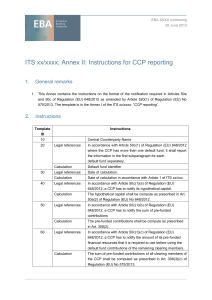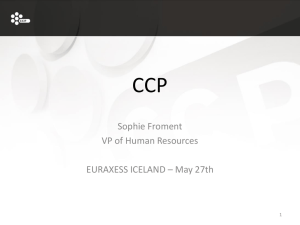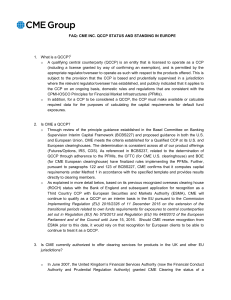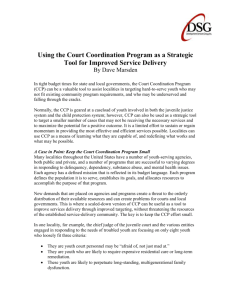Consultation Paper - European Banking Authority
advertisement
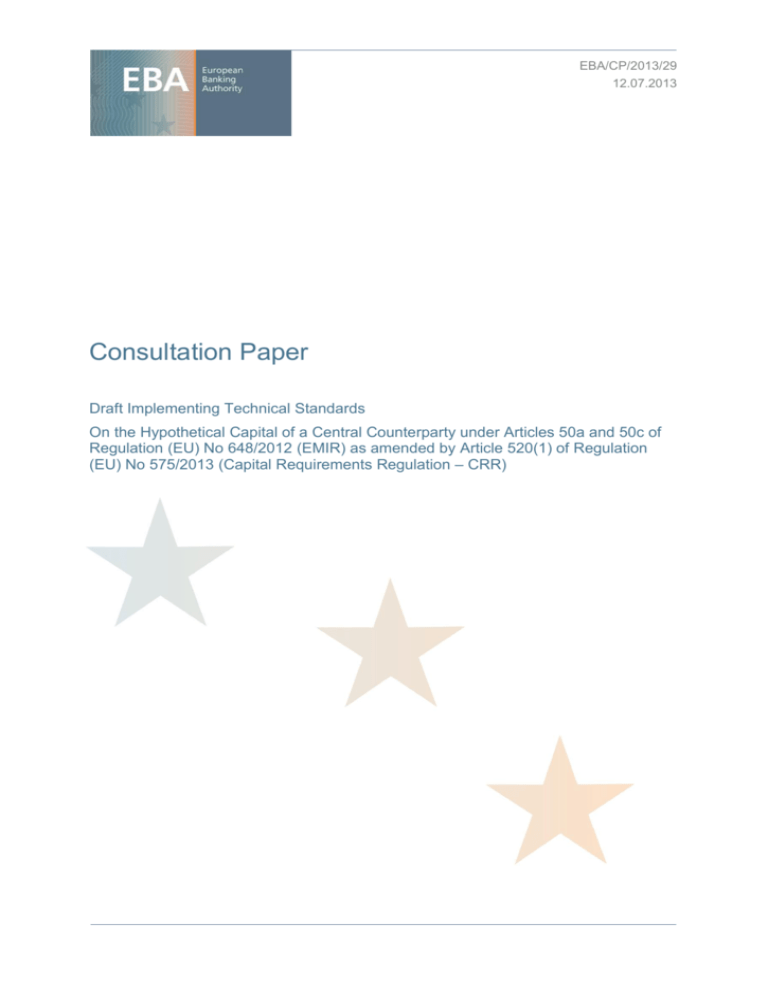
EBA/CP/2013/29 12.07.2013 Consultation Paper Draft Implementing Technical Standards On the Hypothetical Capital of a Central Counterparty under Articles 50a and 50c of Regulation (EU) No 648/2012 (EMIR) as amended by Article 520(1) of Regulation (EU) No 575/2013 (Capital Requirements Regulation – CRR) Consultation Paper on Draft ITS on the Hypothetical Capital of a Central Counterparty under Articles 50a and 50c of Regulation (EU) No 648/2012 (EMIR) as amended by Article 520(1) of Regulation (EU) No 575/2013 (Capital Requirements Regulation – CRR) Table of contents 1. Responding to this Consultation 1 2. Executive Summary 2 3. Background and rationale 3 4. Draft ITS on Hypothetical Capital of a Central Counterparty under Articles 50a and 50c of Regulation (EU) No 648/2012 (EMIR) as amended by Article 520 (1) of Regulation (EU) No 575/2013 (Capital Requirements Regulation - CRR) 4 5. Accompanying documents 12 5.1 Draft Cost- Benefit Analysis / Impact Assessment 12 5.2 Overview of questions for Consultation 16 Page 2 of 18 1. Responding to this consultation The EBA invites comments on all proposals put forward in this paper and in particular on the specific questions summarised in 5.2. Comments are most helpful if they: respond to the question stated; indicate the specific point to which a comment relates; contain a clear rationale; provide evidence to support the views expressed/ rationale proposed; and describe any alternative regulatory choices the EBA should consider. Submission of responses To submit your comments, click on the ‘send your comments’ button on the consultation page by 30 September 2013. Please note that comments submitted after the deadline, or submitted by other means, may not be processed. Publication of responses All contributions received will be published following the close of the consultation, unless you request otherwise. Please indicate clearly and prominently in your submission any part you do not wish to be publicly disclosed. A standard confidentiality statement in an e-mail message will not be treated as a request for non-disclosure. A confidential response may be requested from us in accordance with the EBA’s rules on public access to documents. We may consult you if we receive such a request. Any decision we make not to disclose the response is reviewable by the EBA’s Board of Appeal and the European Ombudsman. Data protection Information on data protection can be found at www.eba.europa.eu under the heading ‘Legal Notice’. Page 1 of 18 2. Executive summary Regulation (EU) No 575/2013 (‘CRR’) sets out prudential requirements for banks’ exposures to central counterparties (CCPs) in Articles 300 to 311. Article 520(1) of the CRR amends Regulation (EU) 648/2012(‘EMIR’) introducing in Title IV the new articles from 50a to 50d. By this amendment, EMIR introduces in Article 50a ‘Calculation of KCCP’ and Article 50c ‘Reporting of information’ specific mandates for EBA to develop draft Implementing Technical Standards (‘ITS’) concerning the reporting of the hypothetical capital of a Central Counterparty (CCP). This set of ITS is required to be delivered to the Commission by 1 January 2014. This consultation paper puts forward draft ITS specifying a quarterly frequency and the template for the information that a CCP has to deliver to all the credit institutions and investment firms that are clearing members, as well as to the supervisory authorities competent for those clearing members. Furthermore, the draft ITS specify the conditions under which the supervisory authorities may require to increase the frequency of reporting: when the own contribution of the CCP to the default fund is used and/or when the CCP has to access to the contributions of the non-defaulting clearing members to the default fund. In the extreme cases where a CCP has to use the default fund, the frequency of reporting is set to daily in order to keep clearing members and competent authorities updated at all times. Page 2 of 18 3. Background and rationale According to Article 50a and 50c of Regulation (EU) No 648/2012 (‘EMIR’), a Central Counterparty (CCP)has to calculate its hypothetical capital and communicate it to all the credit institutions and investment firms acting as clearing members, and to their competent authorities. The clearing members can then use the hypothetical capital to calculate the own funds requirements according to Articles 300 to 311 of Regulation (EU) No 575/2013(CRR). Article 50a(4) of the EMIR delegates powers to the EBA to draft and to the Commission to adopt ITS specifying the frequency and dates of the calculations of the information related to the hypothetical capital and the situations in which the competent authority of an institution acting as a clearing member may require higher frequencies of calculation. Furthermore, Article 50c(3) of the amended EMIR mandates the EBA to draft ITS specifying the frequency, dates and format of the reporting and the situations in which the competent authority may require higher frequencies of reporting. Article 50c requires at least a quarterly reporting of the information related to the hypothetical capital. Accordingly, these draft ITS require that the reporting be delivered on a quarterly basis, with the dates set coherently with the Common Reporting Framework (COREP). According to these draft ITS, there are only two exceptions where the frequency of computation and notification can be increased: when the default contribution of the CCP is used and/or when the CCP has to access the contributions of the non-defaulting clearing members. The losses following the default of a clearing member would, in the first instance, be covered by the initial margin and by the default fund contribution of the defaulting member itself. If these are insufficient, the losses would be covered by the CCP’s own resources and by the pre-funded default fund contributions of the non-defaulting members. Assuming that these resources were sufficient to cover all the losses, the non-defaulting member would also have to replenish its default fund contributions and the CCP would have to replenish its 1 pre-funded own financial resources ( ). Since these situations can be interpreted as periods of stress for the CCP, the competent authority of the clearing members has the possibility to set a higher notification frequency. The higher frequency can be maintained until the above contributions are fully restored. The EBA shall submit the final draft ITS to the European Commission by 1 January 2014. 1 ( ) Commission Delegated Regulation (EU) No 153/2013 of 19 December 2012 supplementing Regulation (EU) No 648/2012 of the European Parliament and of the Council with regard to regulatory technical standards on requirements for central counterparties. Page 3 of 18 4. Draft ITS on hypothetical capital of a Central Counterparty under Articles 50a and 50c of Regulation (EU) No 648/2012 (EMIR) as amended by Article 520 (1) of Regulation (EU) No 575/2013(Capital Requirements Regulation–CRR) In between the text of the draft ITS that follows, further explanations on specific aspects of the proposed text are occasionally provided, which either offer examples or provide the rationale behind a provision, or set out specific questions for the consultation process. Where this is the case, this explanatory text appears in a framed text box. Contents EUROPEAN COMMISSION Brussels, XXX […](2012) XXX draft COMMISSION IMPLEMENTING REGULATION (EU) No …/.. of XXX […] Page 4 of 18 COMMISSION IMPLEMENTING REGULATION (EU) No …/...laying down implementing technical standards with regard to the hypothetical capital of a Central Counterparty according to Regulation (EU) No 648/2012 as amended by Regulation (EU) No 575/2013 of the European Parliament and of the Council Of XXX THE EUROPEAN COMMISSION, Having regard to the Treaty on the Functioning of the European Union, Having regard to Regulation (EU) 648/2012 of 27 July 2012 of the European Parliament and of the Council on on OTC derivatives, central counterparties and trade repositories2 and in particular Articles 50a and 50c thereof, as amended by Article 520 of Regulation (EU) No 575/2013, Explanatory text for consultation purposes For the convenience of the reader, we report here an extract of the text of Arts. 50a and 50c of the EMIR as amended by Art. 520 of Regulation (EU) No 575/2013. These articles introduce the mandates for the EBA to draft the technical aspects (dates, frequencies and formats) concerning CCP’s reporting on information related to hypothetical capital. In particular Art. 50a requires to specify the calculation dates and situations in which a competent authority can ask for higher frequencies of calculation: ‘Article 50a Calculation of KCCP 1. For the purposes of Article 308 of Regulation (EU) No 575/2013 of the European Parliament and of the Council of 26 June 2013 on prudential requirements for credit institutions and investment firms, where a CCP has received the notification referred to in Article 301(2)(b) of that Regulation, it shall calculate KCCP as specified in paragraph 2 of this Article for all contracts and transactions it clears for all its clearing members falling within the coverage of the given default fund. 2. A CCP shall calculate the hypothetical capital (KCCP ) as follows: […] 3. A CCP shall undertake the calculation required by paragraph 2 at least quarterly or more frequently where required by the competent authorities of those of its clearing members which are institutions. 4. EBA shall develop draft implementing technical standards to specify the following for the purpose of paragraph 3: (a) the frequency and dates of the calculation laid down in paragraph 2; (b) the situations in which the competent authority of an institution acting as a clearing member may require higher frequencies of calculation and 2 OJ L 201, 27.7.2012, Page 5 of 18 reporting than those referred to in point (a). EBA shall submit those draft implementing technical standards to the Commission by 1 January 2014. Power is conferred on the Commission to adopt the implementing technical standards referred to in the first subparagraph in accordance with Article 15 of Regulation (EU) No 1093/2010.’ Art. 50c requires to specify the dates, formats and situations in which a competent authority can ask for higher frequencies of reporting: ‘Article 50c Reporting of information 1. For the purposes of Article 308 of Regulation (EU) No 575/2013, a CCP shall report the following information to those of its clearing members which are institutions and to their competent authorities: (a) the hypothetical capital (K CCP ); (b) the sum of pre-funded contributions (DF CM ); (c) the amount of its pre-funded financial resources that it is required to use by law or due to a contractual agreement with its clearing members - to cover its losses following the default of one or more of its clearing members before using the default fund contributions of the remaining clearing members (DF CCP ); (d) the total number of its clearing members (N); (e) the concentration factor (β), as set out in Article 50d; (f)3 the sum of all of the contractually committed contributions DF cCM. Where the CCP has more than one default fund, it shall report the information in the first subparagraph for each default fund separately. 2. The CCP shall notify those of its clearing members which are institutions at least quarterly or more frequently where required by the competent authorities of those clearing members. 3. EBA shall develop draft implementing technical standards to specify the following: (a) the uniform template for the purpose of the reporting specified in paragraph 1; (b) the frequency and dates of the reporting specified in paragraph 2; (c) the situations in which the competent authority of an institution acting as a clearing member may require higher frequencies of reporting than those referred to in point (b). EBA shall submit those draft implementing technical standards to the Commission by 1 3 Explanatory text for consultation purposes: point (f) in the list above is not required for the calculation of the hypothetical capital of a CCP under Article 308 of Regulation 575/2013 (CRR). It is nonetheless required in Article 50c of Regulation 648/2012 (EMIR), as amended by Regulation 575/2013; hence it has been included in these proposed draft Technical Standards. Page 6 of 18 January 2014. Power is conferred on the Commission to adopt the implementing technical standards referred to in the first subparagraph in accordance with Article 15 of Regulation (EU) No 1093/2010.’ Whereas: (1) Credit institutions are currently reporting their capital requirements on a quarterly basis. Therefore, in order to minimise inconsistencies in the reference dates between credit institutions and Central Counterparties (‘CCPs’) which could lead to increased costs, reference dates for the calculation of the information to be notified by the CCPs should be coherent with the reference dates already set for credit institutions. (2) The remittance dates should be delayed by one week with respect to the date of calculation in order to allow the CCPs to perform all the internal controls and complete the necessary approval process. (3) Based on Regulation (EU) 648/2012 the losses following the default of a clearing member would, in the first instance, be covered by the initial margin and by the default fund contribution of the defaulting member itself. When these turn out to be insufficient, the losses are covered by the CCPs’ pre-funded own financial resources in the default waterfall and by the pre-funded default fund contributions of the nondefaulting members. During this time, the frequency of reporting should be increased in order to keep the other non-defaulting clearing members and the competent authorities updated. The CCPs should have the technical capabilities and the internal processes in place in order to compute and deliver the information related to the hypothetical capital under these stress situations. (4) According to Art. 36(3) of the Commission Delegated Regulation (EU) No 153/2013 of 19 December 2012 supplementing Regulation (EU) No 648/2012 of the European Parliament and of the Council with regard to regulatory technical standards on requirements for central counterparties,4 a CCP has to to replenish its pre-funded own financial resources in the default waterfall within one month. For this reason, the calculation and reporting in these situations should be set to frequencies higher than one month. (5) The provisions in this Regulation are closely linked, since they deal with the calculation and reporting of the hypothetical capital of a CCP. To ensure coherence between those provisions, which should enter into force at the same time, and to facilitate a comprehensive view and compact access to them by persons subject to those obligations, it is desirable to include all the implementing technical standards required by Regulation (EU) No 575/2013 in a single Regulation. (6) This Regulation is based on the draft implementing technical standards submitted by the European Banking Authority to the Commission. (7) The European Banking Authority has conducted open public consultations on the draft implementing technical standards on which this Regulation is based, analysed the potential related costs and benefits and requested the opinion of the Stakeholder Group established in accordance with Article 37 of Regulation (EU) No 1093/2010. 4 OJ, L52, 23.02.2013, p.61 Page 7 of 18 HAS ADOPTED THIS REGULATION: Article 1 Frequency and dates of the calculation required by Article 50a(3) of Regulation (EU) 648/2012 1. The frequency of the calculation specified in paragraph 3 of Article 50a of Regulation (EU) 648/2012 shall be quarterly unless the conditions of paragraph 1 of Article 3 are met, in which case they shall be either weekly or daily, depending on the seriousness of the situation, including the degree of depletion or potential depletion of the pre-funded financial resources. 2. Where the frequency of the calculation of paragraph 1 is quarterly, the dates of calculation shall be: 31st March, 30th June, 30th September and 31st December, with reference date of calculation the previous working day. 3. Where a weekly or daily frequency of calculation is required according to paragraph 1 of Article 3, the dates of calculation shall be as soon as possible and no later than the day following the date of the request of the competent authority. 4. Where the day of the calculation of paragraph 1 is a public holiday, Saturday or Sunday, the calculation shall be carried out on the following working day. Article 2 Frequency, dates and uniform format of the reporting required by Article 50c(2) of Regulation (EU) 648/2012 1. The frequency of the reporting specified in paragraph 2 of Article 50c of Regulation (EU) 648/2012 shall be the same as the frequency of calculation specified in paragraph 1 of Article 1. 2. Where the frequency of the reporting of paragraph 1 is quarterly, the remittance dates shall be within five working days after the calculation dates set in Article 1. 3. Where a weekly frequency of reporting is required according to paragraph 1 of Article 3, the CCP shall notify its clearing members and report to the competent authorities as soon as possible and no later than the five working days following the date of the request of the competent authority. 4. Where a daily frequency of reporting is required according to paragraph 1 of Article 3, the CCP shall notify its clearing members and report to the competent authorities as soon as possible and no later than the working day following the date of the request of the competent authority. 5. Where the day of the reporting of paragraph 1 is a public holiday, Saturday or Sunday, the reporting shall be transmitted on the following working day. Page 8 of 18 6. The reporting specified in paragraph 1 shall be submitted using the template set out in Annex I (CCP Reporting) completed according to the instructions set out in Annex II (Instructions for CCP Reporting). Q 1. Do you agree with the frequencies, dates and formats set in Articles 1 and 2? Q 2. Do you agree that the remittance dates should be set to five working dates after calculation under normal circumstances? Q 3. Should the reporting frequency be higher in order to allow those clearing members that need to compute their capital requirements more frequently to do so? What would be the proper frequency and appropriate remittance dates? Article 3 Conditions for higher frequencies of calculation and reporting according to Articles 50a, third subparagraph and 50c, second subparagraph of Regulation (EU) 648/2012 1. By virtue of Article 50a, third subparagraph and Article 50c, second subparagraph of Regulation (EU) 648/2012, competent authorities of an institution acting as a clearing member may require higher frequency of calculation and reporting than those required in Article 1 in the following situations: (a) where, following the default of one clearing member, a CCP is obliged to use any portion of its pre-funded own financial resources in the default waterfall in accordance with Article 43 of Regulation (EU) 648/2012; and/or (b) where, following the default of one clearing member a CCP is obliged to make use of the default fund contributions of non-defaulting clearing members in accordance with Article 42 of Regulation (EU) 648/2012. 2. Where a higher frequency of calculation and reporting is required according to point (a) of paragraph 1, it shall apply until the CCP’s pre-funded own financial resources in the default waterfall are restored at the levels set in Article 36 of the Commission Delegated Regulation (EU) No 153/2013.5 3. Where a higher frequency of calculation and reporting is required according to point (b) of paragraph 1, it shall apply until the default fund contributions of the non-defaulting members are restored at the levels set in Article 42 of Regulation (EU) No 648/2012.6 Q 4. Do you agree with the conditions set in Article 3? Would you add or change any of the conditions set in this Article? 5 6 OJ, L52, 23.02.2013, p.61 OJ, L201, 27.07.2012, p.1 Page 9 of 18 Article 4 This Regulation shall enter into force on the twentieth day following that of its publication in the Official Journal of the European Union. This Regulation shall be binding in its entirety and directly applicable in all Member States. Done at Brussels, For the Commission The President On behalf of the President [Position] Page 10 of 18 ANNEX Annex I: Template for CCP reporting Annex II: Instructions for the Template for CCP reporting [Separate files] Page 11 of 18 5. Accompanying documents 5.1 Draft cost–benefit analysis/impact assessment Introduction Pursuant to Article 15(1) second subparagraph of the EBA Regulation (Regulation (EU) No 1093/2010 of the European Parliament and of the Council), any draft technical standards developed by the EBA will have to be accompanied by a separate note on impact assessment (IA) which analyses the ‘potential related costs and benefits’ (unless such analyses are disproportionate in relation to the scope and impact of the draft technical standard concerned or in relation to the particular urgency of the matter). Article 50a and 50c of the amended EMIR requires the EBA to develop draft Implementing Technical Standards (ITS) relating to: (i) the frequencies and dates according to which Central Counterparties (CCPs) shall compute hypothetical capital; (ii) the frequencies, dates and formats according to which CCPs shall notify to clearing members and the supervisors the latter variables listed in Article 50c points (a) to (g); (iii) the situations in which the competent authority of an institution acting as a clearing member may require higher frequencies of calculation and reporting than those specified under points (i) and (ii). Problem definition and objectives Robustly risk-managed and resilient institutions, in relation to central clearing transactions, contribute to the general regulatory objectives of financial stability and systemic risk mitigation. By specifying the frequency of calculation of hypothetical capital, the notification standards covering variables related to the default fund and the conditions under which notification to clearing members and supervisors can be required at a higher frequency, the proposed ITS contributes to establishing effective and harmonised supervisory practices. Effective and harmonised supervision is instrumental in ensuring that institutions are robustly risk-managed and resilient and, consequently, in achieving the above-mentioned objectives of financial stability and systemic risk mitigation. Baseline scenario In the past, regulatory framework credit institutions and investment firms were not required to hold regulatory capital against the risk exposure stemming from the participation in the default fund of CCPs. The calculation and use of hypothetical capital for regulatory purposes is a new requirement for credit institutions, and so are the reporting requirements for hypothetical capital and the variables related to the default fund. In order to assess the impacts of the proposed ITS, and related costs and benefits, two specific features of the baseline need to be considered: a) The above-mentioned requirements are newly introduced by the CRR and not by the proposed draft ITS. By establishing the related frequencies of calculation, and frequencies, Page 12 of 18 dates and formats of notification, the proposed ITS only marginally affect potential costs and benefits arising from the CRR provisions. b) Even though the mentioned requirements are new, it is expected that all the required data and information are already available to CCPs as a result of currently existing margining, prefunded contributions andrisk management practices carried out in the activities of central clearing. Impacts on institutions, regulators and markets The realisation of the regulatory objectives of effective and harmonised supervision, and their contribution to overall financial stability and systemic risk mitigation, constitute the benefits of the proposed ITS. The overall qualitative assessment of the provisions proposed in the draft ITS relies on the expectation of no material costs arising, for both CCPs (compliance costs) and the supervisory authorities of the clearing members (costs of supervision), as a result of the reporting requirements included in Articles 50a and 50c of the amended EMIR. Such expectation is grounded on the very limited scope of content of such requirements as well as on the assessment of the currently existing market practices (see ‘Baseline’ above). The proposals in the ITS relate to the standalone notification, the circumstances triggering more frequent notification and the proposed levels of higher frequency are not expected to substantially affect costs for CCPs and the supervisory authorities of the clearing members. Q 5. Do you agree with the assessment of non-materiality of costs arising, for clearing members, supervisors and CCPs, from the calculation and notification requirements set out in Article 299 of the CRR? If not, could you provide an estimate of the relative increase in operational costs resulting from the requirements? (Please specify whether costs are one-off or ongoing, and which requirement mostly drives these costs.) Links with wider reporting framework: integration in COREP or standalone notification In introducing the proposed notification requirements in the existing overall regulatory reporting framework, the EBA gave consideration to whether such notification requirements should constitute a new standalone framework or be included as an additional segment of the already existing COREP reporting framework. The advantages and disadvantages of the two approaches are reported below. Option 1: Integration of the proposed notification requirements within the COREP framework Advantages: The integration of the notification to supervisors within the COREP framework could minimise the administrative burden embedded in the coexistence of several different reporting frameworks, each characterised by own and potentially different dates, formats and frequencies. This advantage is, however, mitigated by the fact that no material compliance costs are expected to arise, for CCPs, as a consequence of the required reporting tasks at a default quarterly frequency. Page 13 of 18 Disadvantages: The scope for integrating the reporting requirements in the COREP framework is very limited, given that it could be implemented only in those jurisdictions that require the CCPs to hold a banking licence. According to available evidence, only afew jurisdictions in the EU currently supervise CCPs that hold a banking licence. Unlike the other items reported within COREP, the hypothetical capital of a CCP and the identified quantities related to the features of the CCP’s default fund do not refer, in this reporting framework, to any requirement imposed on CCPs. Option 2: Inclusion of the notification requirements in a standalone framework Proposed option: The disadvantages described under option 1 are arguments in favour of a standalone reporting framework, which is, consequently, the preferred option (option 2). Q 6. Do you agree with the choice of the standalone notification as preferred option? Higher frequencies of notification under the exceptional circumstances specified in Article 3. In order to propose a higher frequency of calculation of the hypothetical capital as well as a higher frequency of notification, the EBA gave consideration to two alternative frequencies higher than the proposed default quarterly frequency. The advantages and disadvantages of the two approaches are reported below. Option 1: Monthly frequency of notification Advantages: Being higher than the default quarterly frequency, a monthly frequency of notification to clearing members and to the clearing members’ supervisors could potentially ensure that: a) a more timely and effective supervision of the risks related to the participation to a CCP’s default fund can be carried out by the supervisors of the clearing member in circumstances where such risks happen to increase, and b) a more timely and effective risk management reaction is warranted on the side of clearing members. 7 Disadvantages: According to the regulation applicable to CCPs ( ), however, the clearing members’ contributions and the CCP’s pre-funded own financial resources in the default waterfall have to be replenished within one month. A monthly frequency of notification turns out to be too low, in this respect, in that the time interval between two subsequent notifications is wide enough to include an event of stress to the default and the mandated replenishment of the latter. In other words, under monthly notification operations, a potential event of stress affecting the default fund of the CCP is likely to occur without either the supervisor or the clearing members being notified in a timely manner. Being higher than the default quarterly frequency, a monthly frequency of notification implies a larger administrative reporting burden, which, however, is not expected to be material. 7 ( ) OJ, L52, 23.02.2013. Page 14 of 18 Option 2: Frequency of notification higher than monthly: daily or weekly frequency Advantages: A daily frequency guarantees, to a larger extent, the advantages described for the monthly frequency option in terms of timely supervision and clearing members’ risk management. In particular, the frequency is compatible with the monthly requirement for the replenishment of the contributions to the CCP’s default fund. Disadvantages: Being higher than the default quarterly frequency and the alternative monthly frequency, a daily or weekly frequency of notification implies a larger administrative reporting burden which, however, is not expected to be material. Proposed option: Given the considerations presented above, the daily frequency of notification is the preferred option (option 2). Q 7. Could you estimate the relative increase in operational costs resulting from switching from a quarterly frequency to a daily frequency of reporting? Page 15 of 18 5.2 Overview of questions for consultation Q 1. Do you agree with frequencies, dates and formats set in Articles 1 and 2? Q 2. Do you agree that the remittance dates should be set to five working days after calculation under normal circumstances? Q 3. Should the reporting frequency be higher in order to allow those clearing members that need to compute their capital requirements more frequently to do so? What would be the proper frequency? Q 4. Do you agree with the conditions set in Article 3? Would you add or change any of the conditions set in this Article? Q 5. Do you agree with the choice of the standalone notification as preferred option? Questions for the cost–benefit analysis: Q 6. Do you agree with the assessment of non-materiality of costs arising, for clearing members, supervisors and CCPs, from the calculation and reporting requirements? If not, could you provide an estimate of the relative increase in operational costs resulting from the requirements? (Please specify whether costs are one-off or ongoing, and which requirement mostly drives these costs.) Q 7. Could you estimate the relative increase in operational costs resulting from switching from a quarterly frequency to a daily frequency of reporting? Page 16 of 18
